Invisalign Clear Braces - Astoria, NY
Straighten Your Teeth to Achieve a Flawless Smile
Traditionally, straightening teeth meant completing advanced orthodontic services that used brackets and wires to shift the smile into alignment. Today at ED Family Dental in Astoria, we are happy to offer a quicker, cosmetically superior alternative – Invisalign clear braces. If you want to learn more about your Invisalign and our other treatment options, call our Astoria dentistry practice to schedule an orthodontic consultation appointment with us today. We’ll review your treatment goals, evaluate your current bite alignment, and partner with you to create an orthodontic treatment plan that will give you the flawless and functional smile you deserve.
What is Invisalign?
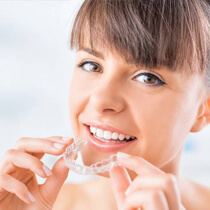
Invisalign is a unique orthodontic treatment plan that utilizes clear alignment trays rather than brackets and wires to shift teeth into their ideal alignment. In the past, Invisalign was only used to adjust minor alignment concerns like spacing, but today, we can utilize the Invisalign clear braces system to treat more advanced issues like over, under, and crossbite.
How does Invisalign Work?
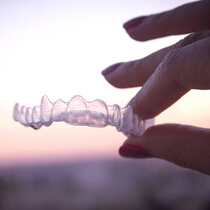
Invisalign clear braces plans use a series of plastic alignment trays to shift teeth into their desired position. Every set of aligners is crafted precisely to represent the placement of teeth a step nearer to the results you’re after. Patients wear the aligners for two weeks at a time. Then, simply exchange their current alignment trays for the next in the series. For eight to eighteen months you’ll continue your Invisalign treatment until you achieve the desired end result. Throughout treatment, you’ll only need to visit our office every six to eight weeks for short checkup exams. During these periodic checkups, we simply make sure your smile is shifting according to the current plan, and our team can make adjustments to ensure you achieve your desired results in the time you planned.
Who Should Consider Invisalign?
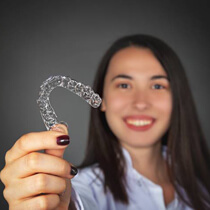
Before beginning an orthodontic treatment plan, patients should take the time to consider all of their options. Those patients who are most likely to benefit from treatment with Invisalign include:
- Patients who can’t fit frequent orthodontist appointments into their schedules
- Those who have allergies or sensitivities to metal
- Those who want to maintain their professional images during orthodontic treatment
- Patients who don’t want to change their diets or oral hygiene routines significantly
Who Can Invisalign Help?
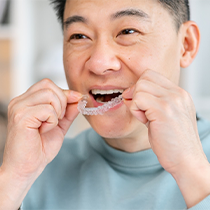
If you have alignment issues, this doesn’t mean that you need to undergo multiple years of wearing metal braces! Invisalign is able to correct a wide range of bite and alignment issues. Continue reading to learn about all of the different ways that Invisalign can correct smiles.
Crowded Teeth

A very common orthodontic problem consists of overcrowding. This can negatively impact both your oral health and your bite. It can even make it more difficult for you to maintain excellent oral hygiene. The good news is that clear aligners can shift your teeth to be the perfect distance apart. This can improve the appearance, health, and function of your smile in the process.
Gaps Between Teeth
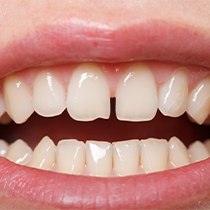
Just like crooked teeth, teeth that are spaced too far apart can impact your self-esteem. They can also trap food debris and increase your risk of developing tooth decay and gum disease. With Invisalign, your trays can closely close gaps in your smile until all of your teeth are perfectly aligned.
Overbite
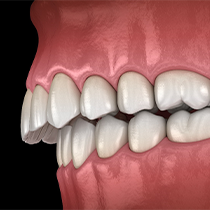
Overbites happen when the top teeth come out too far from the lower arch of the teeth. Overbites result in jaw pain, speech issues, uneven dental wear, and difficulty opening and closing the mouth. This problem can also leave the top teeth more exposed, putting them at higher risk of becoming injured.
Underbite
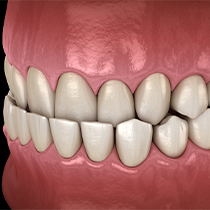
An underbite describes when the bottom teeth go slightly passed or match with the top row of teeth when you close your mouth. This can be caused by several different factors, including genetics, jaw injury, and nonnutritive habits (like thumb sucking and pacifier use after a certain age). Oftentimes, patients with underbites require the use of rubber bands and other attachments to be used in combination with Invisalign aligners. This ultimately helps to gradually address the bite and shift the lower arch into its proper location.
Crossbite

When the bottom teeth are slightly in front of the upper arch, this is known as a “crossbite.” This is usually due to genetics, poor oral habits, or premature loss of the primary teeth. When left unaddressed, crossbites can lead to other issues, like increased risk of gum disease, tooth decay, speech difficulties, headaches, teeth grinding, and facial asymmetry. Invisalign can correct this issue in most cases. However, if your crossbite is caused by issues involving jaw development, it might be necessary to accompany the aligners with elastic and other accessories.
Open Bite
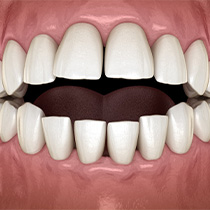
An open bite is when the top and bottom front teeth aren’t able to overlap or touch when you close your mouth completely. In most cases, this is due to poor bone development or nonnutritive habits, like prolonged thumb sucking and pacifier use. An open bite can lead to difficulty pronouncing certain words and sounds, as well as excessive enamel wear of the back teeth. Invisalign can bring the top and bottom teeth together, correcting the bite pattern and reducing additional oral damage.
Benefits of Invisalign

There is no treatment that is right for every patient, so in order to choose the best treatment to meet your needs, you’ll need to consider the advantages of each option. With that said, more than 12 million patients around the world have chosen Invisalign because it comes with several noteworthy perks! If you’re interested in learning a few of them, keep reading.
Improved Comfort

Traditional braces are known for being uncomfortable at times. This is largely because of the brackets and wires, which can irritate the soft tissue in your mouth relatively easily. Fortunately, Invisalign takes a different approach; it uses low-profile, smooth, custom-made, and (perhaps most importantly) metal-free aligners to address crooked teeth, overbites, and other common orthodontic problems.
Natural Appearance

Even with clear or white rubber bands, traditional braces can be quite noticeable. If this is a concern of yours, then consider choosing Invisalign! Since the aligners are completely see-through, they will blend in seamlessly with your smile when worn. In other words, this orthodontic treatment ensures your grin will look flawless during every step of your teeth-straightening journey.
Hassle-Free Dental Hygiene
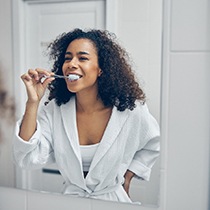
If you already find brushing and flossing to be cumbersome, then traditional braces may not be right for you. After all, patients often need special oral hygiene tools, like interproximal toothbrushes, in order to thoroughly clean their teeth, gums, brackets, and wires. Conversely, completing your dental care regimen with Invisalign is easy because all you need to do is take off your aligners and proceed as usual!
Quick Follow-Ups
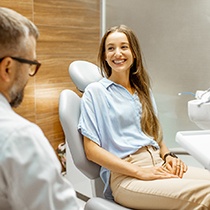
Each check-in appointment is usually around 15 minutes, which makes it convenient to schedule on your lunch break or on your way home from the office. When you arrive, we will ask you a few questions about how your treatment is going, take new scans of your teeth, assess how your teeth are tracking in comparison to your plan, and send you on your way with your next batch of aligners!
Saved Time
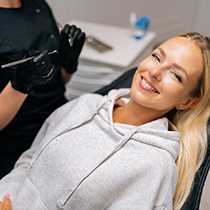
A big perk for patients of all ages is the shorter average treatment time (between 12 and 18 months). There’s also another benefit that we want to mention in this section: the visits are usually every 6-8 weeks instead of every 4 weeks like traditional braces. That means less time in our office and more time doing everything else on your calendar!
No Dietary Restrictions

The start of your orthodontic treatment won’t mean the end of eating all of your favorite foods because Invisalign doesn’t require you to change your diet! All you need to do is remove your aligners before eating and make an active effort to eat well-balanced meals that are lower in added sugar.
Note: Make sure to remove your trays before drinking coffee too!
Living with Invisalign Aligners

Invisalign is a smart strategy for straightening teeth with many unique benefits over traditional metal braces. However, some patients want to know what it’s like living with clear aligners. What other routines and responsibilities will they need to get used to as they continue their orthodontic treatment? At ED Family Dental, we believe that every patient should have as much knowledge as possible before committing to their treatment plan.
Wearing Your Trays

The defining aspects of Invisalign treatment are the clear aligners. Once your trays are on, you’ll need to continuously wear them throughout the day and even while you sleep. The only times you’ll remove them are during meals, when drinking anything that isn’t water, or for oral hygiene. In total, you’ll need to keep them on for 20 to 22 hours per day, so planning your take-out times is part of the process.
Cleaning Your Aligners
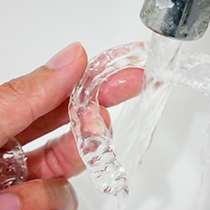
As part of your regular oral hygiene routine, you’ll need to get used to cleaning your aligners as well. Use only cool or lukewarm water when doing so. Heat can warp the plastic of the trays, affecting their fit. For the best results, use a soft bristled toothbrush and a mild, colorless hand soap to clean every surface of your aligners. To keep them fresh between brushing, rinse them off with water to remove food particles and debris each time you take them out.
Eating & Drinking

One of the benefits of Invisalign is the ability to remove your trays. This lets you enjoy all your favorite foods while undergoing treatment. It’s essential to only eat when your aligners are not in your mouth to prevent them from being damaged or stained.
Losing or Damaging a Tray
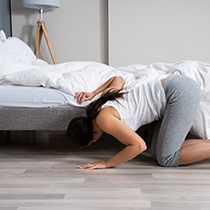
If you happen to lose or damage one of your Invisalign trays, don’t panic! Dr. Shkurti can get your treatment back on track if you address the situation quickly. Sometimes he’ll need to order a new aligner for you, but if you’re nearing the end of a set, he may recommend moving on to the next one in your treatment plan. Be sure to call as soon as possible for instructions.
Routine Check-Ins
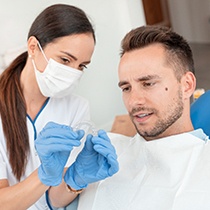
While Invisalign doesn’t require adjustments like traditional braces, you’ll still need to schedule checkups with Dr. Shkurti to have your progress monitored. This generally happens every four to eight weeks depending on your treatment plan. These visits are typically short inspections where you’ll receive the next series of aligners in your treatment and personalized advice for maintaining your progress.
Understanding the Cost of Invisalign

Invisalign in Astoria is widely known for its virtually incognito trays and quicker treatment timeline, but how much does it cost exactly? While there is no all-encompassing answer, there are a few factors that play a role in the final price across the board. Keep reading to learn what they are, as well as which options are available to make achieving your dream smile affordable.
Factors that Affect the Cost of Invisalign

To address each person’s unique dental needs, Invisalign is completely customized. As a result of not providing a “one-size-fits-all” treatment, there is no “one-size-fits-all” price. Therefore, the cost can vary from patient to patient based on:
- Whether you are straightening both your top and bottom arches.
- The overall complexity of your treatment (ex: addressing one small gap vs. correcting severe crowding).
- The length of the proposed treatment.
Invisalign VS Smile Direct Club™: Which Costs More?

Does Dental Insurance Cover Invisalign?

Since many plans don’t include coverage for orthodontic treatment, Invisalign is typically an out-of-pocket expense. With that being said, that isn’t always the case, which is why it is good to check with your provider! If you need any assistance with the process, don’t hesitate to let our team know. Otherwise, you can use your FSA account (if you have one through your employer) to cover the cost.
Options for Making Invisalign Affordable

If you don’t have an individual dental plan or one through your employer, you’ll be happy to know that there is another option: CareCredit. This third-party financier allows you to break up the cost of even the most extensive treatments into monthly, budget-friendly payments. That way, your dream smile is never out of reach. Ask us about utilizing this financial option at your initial consultation!
If you want to straighten your teeth in Astoria, then we are here to help. To ensure your experience is as seamless and stress-free as possible, we encourage you to schedule an initial consultation. From there, we can ensure you are a candidate, learn more about your smile goals, and discuss all the financial details. Give us a call today to schedule yours!
Invisalign FAQs
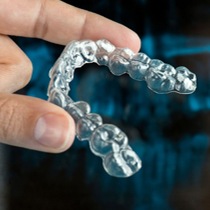
It is natural to want as much information as possible before making a big decision, especially when it’s in regard to your health and physical appearance. That is why we have compiled some of the most common questions – and answers – about Invisalign clear braces. We hope you find our Invisalign FAQ page helpful in answering some of your questions and determining if this treatment is right for you.
After you are finished reading, give us a call at our convenient Astoria location to schedule a consultation with Dr. Shkurti. You will be glad you did!
Does Invisalign Hurt?
When you first start wearing a new set of Invisalign aligners, your teeth may feel a little sensitive for a day or two. This mild discomfort is a sign that Invisalign is working and your teeth are gradually shifting into the desired position. Any discomfort you feel will be temporary and should fade quickly.
How Often Must I Wear My Aligners?
You are key to the success of your Invisalign treatment! Wearing your aligners for the recommended number of hours a day – typically 20 to 22 – is critical to straightening your smile on schedule. Invisalign aligners are easily removable, so you can take them out whenever you eat a meal or clean your teeth – just be sure to put them back in afterwards.
How Do I Keep My Aligners Clean?
You can keep your Invisalign aligners clean by gently brushing them with a toothbrush and toothpaste once per day. After brushing your aligners, rinse them with lukewarm water – never with hot water. Using hot water on aligners can permanently warp the plastic.
Are Invisalign Aligners Chemically Safe?
You can rest easy when wearing your Invisalign aligners. The
clear plastic trays are made from medical-grade thermoplastic polymers that have been approved by the
Federal
Drug Administration (FDA) for long-term use inside the human body. According to the manufacturer, the
biocompatible aligners do not contain any traces of Bisphenol A (BPA), latex, parabens, phthalates,
glutaraldehyde or epoxy.
Can You Eat with Invisalign?
Good news: there aren’t any dietary restrictions with Invisalign! Plus, since you’ll be removing your aligners before eating, you’ll be able to enjoy your meal or snack without any discomfort or irritation.
Note: If you have several attachments, then we may recommend avoiding raw nuts, croutons, and other crunchy foods. Similarly, we recommend keeping your intake of sugary foods to a minimum since they can result in cavities that bring your teeth-straightening journey to a temporary stop.
How Long Does Invisalign Take?
There are multiple factors that impact the answer, starting with the severity of your misalignment and extending to how many aligners you need. However, one that many patients don’t often consider is how well they follow the treatment guidelines. Although the average treatment timeline with Invisalign is only 12 to 18 months, it can be significantly longer if you don’t wear your trays for 20+ hours a day or you constantly lose them. In other words, to get through your series of trays as quickly and efficiently as possible, it’s of the utmost importance that you follow the instructions we give you to a tee!
What if My Invisalign Broke?
If one of your Invisalign aligners broke, do your best not to panic, and don’t wear them! Instead, call our Astoria dental team ASAP to explain what happened. Then, we can take a look at your treatment plan and determine what to do next. If you are only a day or two away from moving onto your next set in the series, we may recommend transitioning to those a bit early. If, on the other hand, you just started the set of broken trays, then we will likely instruct you to wear your previous trays until your replacement ones arrive at our office.
Can You Get Invisalign After Braces?
Many patients do! In fact, it’s very common for patients who had braces as children or teens to get Invisalign as an adult. Even if you’ve never undergone orthodontic treatment, getting Invisalign after traditional braces may be an option. Typically, this is the case for patients who have moderate to severe cases of misalignment that clear aligners can’t correct. This is often referred to as “hybrid orthodontic treatment.”
Does Invisalign Give You a Lisp?
Have you heard that Invisalign gives you a lisp? Don’t worry – 14+ million patients wouldn’t have chosen to straighten their teeth with clear aligners if that was the case. This myth has circulated because there is sometimes an adjustment period when patients first get their trays. The good news is that any changes that do arise will be minor, temporary, and nothing that can’t be fixed with some practice!
